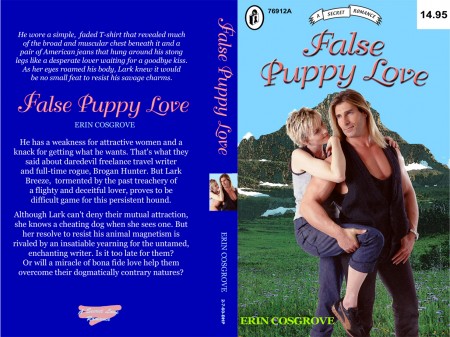
Could you tell us a little bit about the program you’ll be screening for Conversations at the Edge this fall?
A Heart Lies Beneath comes from my 7 Romance Novels Project—which is what it sounds like, sort of—7 romance novels written by 7 different authors, all of them named Erin Cosgrove. They are satires that take the logic of pulp romance novels from the 1960’s to the late 80’s, and magnify their tropes to ridiculous degrees. I made covers for each book that feature myself and Fabio, as a way to visualize where romance and I meet, which is, needless to say, a strange place. A Heart Lies Beneath is based on The Baader-Meinhof Affair, the only book in the series that was published. The video is somewhat like a mini pilot of the book. It was my first foray into animation.
What inspired you to make this work?
I’ll answer this question for the other video I’m screening, What Manner Of Person Art Thou?, which came directly from my second romance novel, False Puppy Love. False Puppy Love had two characters I called the Renegade Hutterites. They were completely fictional creations, as Hutterites are notoriously nonviolent. I needed to make a work that responded to 9/11 and the change of zeitgeist that resulted from it. People flew airplanes into buildings “for god” and “god fearing” people cried for Afghanistan to be bombed into a parking lot. I felt like I had fallen into a wormhole where the Enlightenment never took place, and for the two violent characters in this piece, it hadn’t. I see it as a cautionary tale and a kind of humanist plea.
Tell us a bit about your process: how do you start a piece, and how do you know when it’s finished.
First, I get interested/angry about something. Then I think of a project that might channel or address that interest/anger. Then I throw everything into the project for two to six years. Then I look at the results in abject horror. Then I add, edit, and repeat the last two steps until I can’t stand looking at it anymore. It’s never finished, I’m just done with it.

What have you read recently that is most interesting to you?
This summer I struggled my way through Intuition Pumps and Other Tools for Thinking by Daniel Dennett. There are a couple chapters where Dennett uses the example of an engineer who makes a giant robot to protect the engineer’s frozen body for 400 years into the future. In the end, this thought experiment dismantles some bad “intelligent” design arguments. At the end of the example you may come to think of your autonomy and ultimate life purpose differently. Another book I’ve read recently is a great translation of The Epic of Gilgamesh by Stephan Mitchell. The Epic of Gilgamesh is one of the earliest surviving works of literature, and it’s also engaging, strange, and unabashedly sexual. It famously precedes Noah and the Ark with its own great flood tale. And there are alternate versions of the epic where Gilgamesh and Enkidu appear to be lovers, which seems to prove, unsurprisingly, that fanfics and slash have existed as long as writing has.
Tell us a bit about the next project you’ll be working on.
I’ve been working on The Living Book for four or so years. It’s about the last surviving couple who accidentally destroy all records of human culture. It’s an allegory of cultural and historical amnesia, with a caution that history is what you remember. The title comes from the Christian sect, the Doukhobors. Following the 17th Century Russian Danilo Filipov, who threw his “dead” bible into the Volga river, the Doukhobors created a “living book” of faith transmitted from one generation to the next through song.
Americans have such a bizarre relationship with their past. Even, or is it especially, our politicians who bungle our history. Remember when Congresswoman Michelle Bachman said the Founding Fathers, “…worked tirelessly until slavery was no more in the United States.” When the general populace is more aware of the latest celebutard than they are of, say, Elizabeth Warren, you get cynical. Still, as an artist, I’d like to think that I’m leaving something else behind, my cultural offspring.
Erin Cosgrove will be presenting her work at CATE on Thursday, October 3 at 6PM